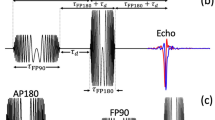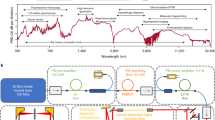Abstract
Raman heterodyne detection is a coherent optical-RF double resonance technique where the optical and RF fields induce coherence within a three level system and a resultant Raman field is measured using heterodyne detection. This approach has been used previously to detect NMR and more recently EPR. In this paper the parameters that affect the amplitude and signal to noise ratio of the Raman heterodyne signals are considered. The power levels in relation to the oscillator strength and dephasing times, the amplitude and spectrum of the laser frequency jitter in relation to the optical homogeneous linewidths and holeburning rates, and the sample properties such as absorption strength and optical quality, are all factors that affect the Raman signal. The presentation is focused on the Raman heterodyne detected EPR of the nitrogen-vacancy pair centre in diamond making comparisons with Raman heterodyne detected NMR signals obtained for rare earth ion systems. RF-RF double resonance studies, RF holeburning and ENDOR, which give information about the hyperfine levels are also reported for the nitrogen-vacancy centre. The resonance frequencies are in agreement with those predicted from the spin Hamiltonian. The factors affecting the lineshapes and relative intensities of the double resonance signals are discussed.
Similar content being viewed by others
References
Mlynek J., Wong N.C., DeVoe R.G., Kintzer E.S., Brewer R.G. Phys. Rev. Lett.50, 993–996 (1983)
Wong N.C., Kintzer E.S., Mlynek J., Brewer R.G.: Phys. Rev. B28, 4993–5010 (1983)
Takahashi Y., Tanaka T., Hatanaka H., Fukuda Y., Hashi T.: J. of Luminescence38, 261 (1987)
Takahashi Y., Ishikawa K., Tanaka T., Fukuda Y., Hatanaka H., Hashi T.: Phys. Rev. B38, 7121–7124 (1988)
Erickson L.E.: Phys. Rev. B39, 6342–6347 (1989)
Mitsunaga M., Kintzer E.S., Brewer R.G.: Phys. Rev. Lett.52, 1484–1487 (1984) and Phys. Rev. B31, 6947–6957 (1985)
Erickson L.E.: Phys. Rev. B42, 3789–3797 (1990)
Erickson L.E.: Phys. Rev. B32, 1 (1985)
Erickson L.E.: J. Phys. C: Solid. State Phys.20, 291–298 (1987)
Bloch P.D., Brocklesby W.S., Harley R.T., Taylor D.R.: J. Physique C7, 523 (1985)
Manson N.B., Silversmith A.J.: J. Phys. C: Solid State Phys.20, 1507–1517 (1987)
Szabo A., Muramoto T., Kaarly R.: Optics Letters13 1075–1077 (1988) and Phys. Rev. B42, 7769–7776 (1990)
Fisk P.T.H., He X.-F., Holliday K., Manson N.B.: J. of Luminescence45, 26–28 (1990)
Holliday K., He X.-F., Fisk P.T.H., Manson N.B.: Optics Letters15, 983–985 (1990)
Manson N.B., He X.-F., Fisk P.T.H.: Optics Letters15, 1094–1096 (1990)
Manson N.B., He X.-F., Fisk P.T.H.: J. of Luminescence (1992)
Abramowitz M., Stegun I.A. in: Handbook of Mathematical Functions. New York: Dover 1965.
Davies G., Hamer M.F.: Proc. R. Soc. Lond. A348, 285–298 (1976)
Davies G.: Chem. Phys. Carbon13, 1 (1977)
Collins A.T., Thomaz M.T., Jorge M.I.B.: J. Phys. C: Solid State Phys.16, 2177–2181 (1983)
Loubser J.H., Wyk J.A.: Diamond Research11, 4 (1977)
Macfarlane R.M., Shelby R.M. in: Spectroscopy of Solids Containing Rare Earth Ions (Kaplyanskii A.A., Macfarlane R.M. eds.), pp. 51–184. Amsterdam: North Holland 1987.
Author information
Authors and Affiliations
Rights and permissions
About this article
Cite this article
Manson, N.B., Fisk, P.T.H. & He, X.F. Application of the Raman heterodyne technique for the detection of EPR and ENDOR. Appl. Magn. Reson. 3, 999–1019 (1992). https://doi.org/10.1007/BF03166169
Received:
Revised:
Issue Date:
DOI: https://doi.org/10.1007/BF03166169




